#contemporary philosophy portal
Explore tagged Tumblr posts
Text
𝙌𝙪𝙤𝙩𝙖𝙗𝙡𝙚 𝙌𝙪𝙤𝙩𝙚𝙨.

❝seem at times, we have to accept that some people can only be in our hearts, not in our lives.❞
— Juan Francisco Palencia.
#writers on tumblr#attempt at poetic action#juan francisco palencia#spilled ink#writing#reflexions of my life#feelings#words from the bottom of the heart#from mexico to the universe#spring 2024#love quote of the day#light academia#love poem#impressions#quotable quotes#life philosophy#contemporary philosophy portal#vitruvio#writers and poets#writer tumblr#literary aesthetic#friendship#love#sad truth
1K notes
·
View notes
Text
“When you find the half that you have been missing, nothing can extinguish love and its light that is born and shines from within.”

[Incidental place where words meet intertwine. Philosophy, Contemporary Literature, thoughts, love, poetry, feelings, minimalism, re' readings, quotes, reglobeo.]
Juan Francisco Palencia.


Be with someone who loves you harder on the days you can't love yourself at all.
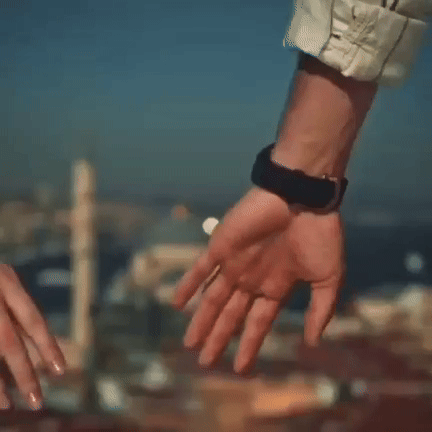

#reglobeo#@likealotus#spilled ink#juan francisco palencia#writing#love poem#reflexions of my life#feelings#love quote of the day#writers on tumblr#life philosophy#light academia#writumblr#contemporary philosophy portal#imagines#vitruvio#impressions
708 notes
·
View notes
Text
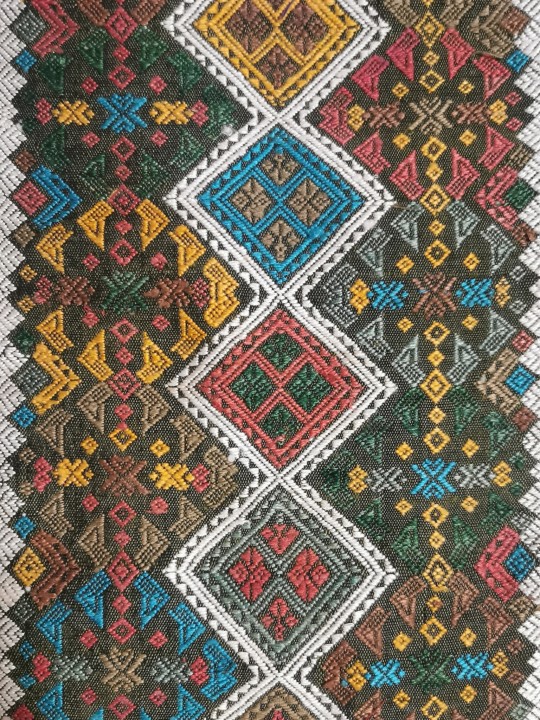
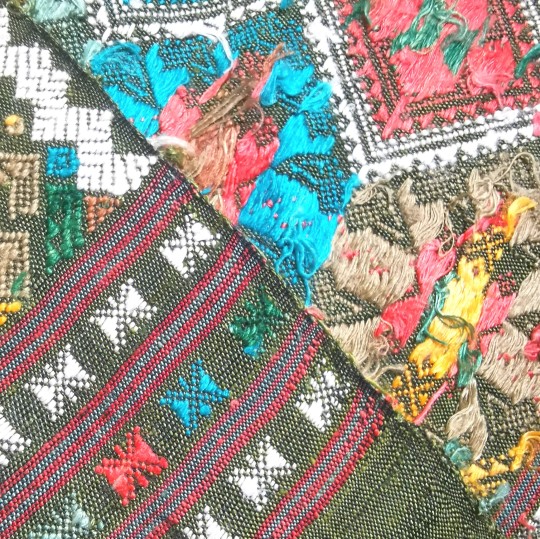
This is a Laos minority tribal textile, a cultural treasure passed down through millennia by its tribal people, is hailed as "an epic worn on the body." With its unique artistic language, it weaves natural elements and ethnic memories into resplendent patterns, embodying the history, beliefs, and aesthetics of its community.
This craft showcases exquisite techniques involving threading, embroidering, weaving, and dyeing, transforming silk threads into brushes of vitality. The geometric diamond patterns in the image, interlaced with vibrant colors of red, blue, and yellow, symbolize the tribe's reverence for cosmic order and admiration of the universe. Layered motifs within the diamond frames resemble portals to time, hinting at the ancestors' cosmic understanding and philosophy.
Each textile piece is a labor of love, crafted over months or even years by artisans. They embroider cultural codes—family stories, festive rituals, and religious taboos—into garments, headdresses, and waistbands, stitch by stitch. Beyond clothing, these textile serve as carriers of minority tribal cultural genes, ensuring ancient civilizations thrive in contemporary life.
Through colors and patterns, Miao embroidery bridges history and the present, nature and humanity. It reminds us that in this rapidly advancing world, cultural traditions rooted in the earth continue to offer profound emotional resonance and spiritual strength
16 notes
·
View notes
Text
The Legacy of Carl Jung and Its Modern Practitioners

Jungian art is profoundly founded in the concepts of Carl Gustav Jung, the prominent Swiss psychiatrist who first proposed the concept of the collective unconscious and its symbolic embodiment in art. To really grasp Jungian art, one must first investigate the life and mind of its creator, Carl Jung, as well as the philosophy that supports it.
Jung’s interest in art stemmed from his psychiatric studies of the human psyche. In his landmark work, The Red Book, he employed visual art to explore his own unconscious and record his inner experiences. This text, which contains elaborate sketches and paintings, functions as an artistic and psychological manifesto. Jung felt that creative activities may allow people to access and express their collective unconscious, which is a shared reservoir of archetypes and symbols across humanity. For Jung, art was more than just a means of self-expression; it was also a tool for individuation — the process of integrating one’s conscious and unconscious selves to reach wholeness.
Today, Jungian art thrives as a discipline that combines psychology and creativity. Jung’s teachings have inspired modern artists to explore subjects such as archetypes, dreams, and symbols. Here are three modern artists whose work strongly resonates with Jungian philosophy:
David Heskin: An artist who enjoys investigating the metaphysical, David Heskin’s works frequently dive into the unconscious, evoking the mystical and archetypal images that Jung adored. His elaborate paintings use geometry, symbols, and surreal imagery to create a spiritual connection with the observer. Heskin regards art as a bridge to the transcendent, just as Jung saw it as a portal to the unconscious.
Leah McDonald: A mixed-media artist whose work explores stereotypes of femininity and metamorphosis. Jung’s theories have influenced her art, frequently depicting rebirth, shadow work, and integration. She employs photography, painting, and encaustic techniques to produce works that inspire beauty and psychological depth, inspiring viewers to explore their inner worlds.
Benedict Rubenstein: A sculptor who draws inspiration from myth and psychology, Rubenstein’s work incorporates Jungian archetypes as a key motif. His sculptures frequently feature characters or forms representing the Hero’s Journey, a theme essential to Jungian philosophy. Rubenstein’s paintings inspire viewers to consider their personal narratives and place in the larger human story.
Jungian art demonstrates the enduring power of symbolism and creativity. It allows both producers and spectators to embark on a journey of self-discovery, delving into the unconscious to reveal universal truths about the human condition. Carl Jung’s legacy lives on, reverberating in the brushstrokes, installations, and tales of contemporary artists who continue to investigate the hidden corners of the psyche. Jung once stated, “The privilege of a lifetime is to become who you truly are.” Jungian art transforms this transforming journey into a vivid, expressive reality.
3 notes
·
View notes
Text
YAYYYY SHEP FINALLY GETS A PINNED POST/INTRO ARC
Hey my name is Shep / Rox and i'm a guy maybe a girl also, 17 years old, will be 18 in October, he/it. Into some really weird media and I've got something going on in my brain
☆☆☆☆☆☆☆☆☆☆
MEDIA Interests :
- The Phantom of the Paradise
- Interstella 5555
-TF2
-Daft Punk
- The Phantom of The Opera
- Arsène Lupin books
- Lupin III
- Dungeon Meshi
- Magical Girl anime
- Sailor Moon
- Portal
- Stardew Valley
GENERAL interests:
- Music Theory, Contemporary Music, Audio Engineering
- Creative Writing
- Art and Art History
- Architectural History
- Makeup
- Philosophy, what is and isn't real
☆☆☆☆☆☆☆☆☆☆
HOBBIES
- Violin, I've played violin for like coming up on 5 years now
- Keyboard, Bass Guitar, Vocals and Singing
- Visual Art
- Playwriting, Composing and Creative Writing
-Crochet
☆☆☆☆☆☆
BOUNDARIES
No flirting unless you know who i am irl ☆
Don't get weird to me and dont be rude or i block ☆
DO NOT PUT WEIRD SHIT IN MY INBOX !!
☆☆☆☆☆☆
Stuff I do (and will do for/with you :-) )
-WRITING : Roleplaying if you DM me about it, i won't roleplay w people who are super younger than me and i am not super into romance right now / On Inbox Request for fanfic, On Commission or Inbox Request for Original Works or Poetry. I WILL NOT CURRENTLY WRITE EXPLICIT CONTENT ON REQUEST OR COMMISSION OR ROLEPLAY, SUBJECT TO CHANGE
- ART: On Inbox Request or Commissioned depending on subject and motivation level, DM me for commissions higher than sketches I WILL NOT CURRENTLY DRAW EXPLICIT CONTENT, SUBJECT TO CHANGE
- COMPOSING AND SONGWRITING: On Comission, DM me for more details
- VIOLIN: coming soon :-)
- RELEASED MUSIC: coming soon :-)
☆☆☆☆☆☆☆
PLEASE PLEASE PLEASE talk to me if you are into my interests and down with me hanging out around you , love you all, bye
RELATED ACCOUNTS
@veinjection art account currently barely used
@kleptomaniask tf2 oc askblog (find the others :) )



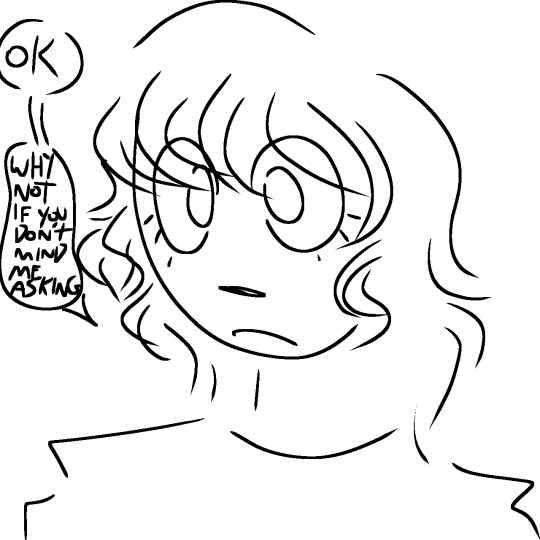

#shepposting#artists on tumblr#violinist#interstella 5555#daft punk#phantom of the opera#poto#my art
5 notes
·
View notes
Text
"Embarking on Enlightenment: A Journey through 'Initiation into Philosophy' by Émile Faguet"
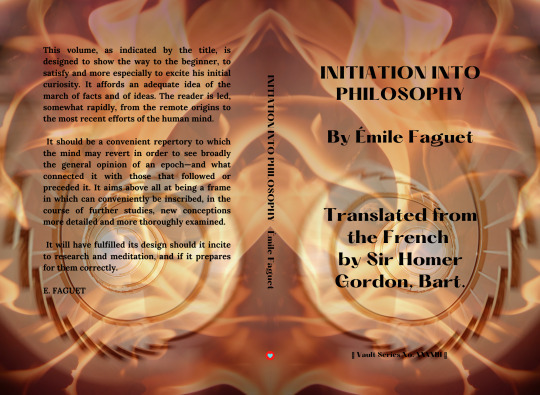
Émile Faguet's "Initiation into Philosophy" serves as a captivating portal into the world of profound ideas and intellectual exploration. This literary gem not only educates but also enthralls, making the initiation into philosophy a thrilling adventure.
Faguet, with eloquence and insight, navigates the intricate landscapes of philosophical thought, presenting complex concepts in a manner accessible to both novices and seasoned philosophers. The book invites readers to ponder the fundamental questions that have shaped human understanding for centuries, sparking a delightful intellectual curiosity.
One of the book's strengths lies in its ability to demystify philosophy, transforming it from an abstract discipline into a vibrant and relevant exploration of life's most profound inquiries. Faguet's narrative style is both engaging and thought-provoking, creating a harmonious balance between scholarly depth and reader-friendly accessibility.
As readers traverse the pages, they encounter a rich tapestry of philosophical traditions, from ancient wisdom to modern theories, each contributing to the mosaic of human thought. Faguet masterfully weaves together key philosophical tenets, offering readers a panoramic view of the discipline's evolution while highlighting its enduring relevance to contemporary life.
The book's thematic organization allows for a seamless journey through the realms of metaphysics, ethics, and epistemology, providing readers with a comprehensive understanding of philosophy's multifaceted nature. Faguet's insights into the works of notable philosophers add a layer of richness, transforming the book into a guide through the intellectual lineage of great thinkers.
"Initiation into Philosophy" is not merely a book; it is an odyssey that beckons readers to embrace the joy of intellectual discovery. Faguet's prose invites reflection, prompting readers to question, contemplate, and savor the intricacies of the philosophical landscape.
In conclusion, Faguet's "Initiation into Philosophy" is an intellectual feast that transcends the boundaries of time. With a captivating blend of erudition and accessibility, the book stands as an enduring testament to the timeless allure of philosophical inquiry, making it a must-read for anyone curious about the profound mysteries of existence.
Émile Faguet's "Initiation into Philosophy" is available in Amazon in paperback 12.99$ and hardcover 20.99$ editions.
Number of pages: 191
Language: English
Rating: 8/10
Link of the book!
Review By: King's Cat
#Philosophy#Émile Faguet#Intellectual Exploration#Philosophical Inquiry#Metaphysics#Ethics#Epistemology#Intellectual Curiosity#Great Thinkers#Human Understanding#Ancient Wisdom#Modern Theories#Thought-Provoking#Scholarly Depth#Thematic Organization#Philosophical Traditions#Existential Questions#Timeless Relevance#Profound Ideas#Intellectual Discovery#Book Review#Contemporary Life#Exploration of Life's Questions#Narrative Style#Intellectual Journey#Erudition#Reflection#Metaphysical Inquiry#Ethics Exploration#Intellectual Odyssey
4 notes
·
View notes
Text
The Spiritual Seek Blog: A Comprehensive Guide to Modern Mystical Wisdom
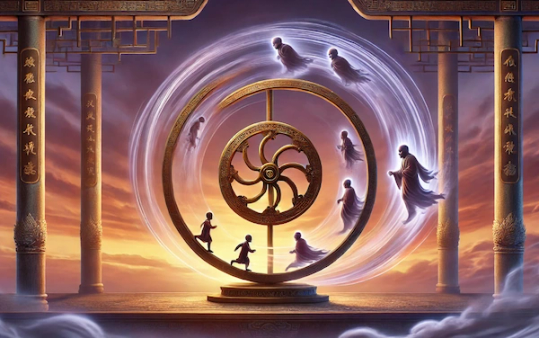
Introduction: Where Ancient Wisdom Meets Contemporary Seekers
In today's rapidly evolving spiritual landscape, finding authentic, well-researched content that bridges timeless wisdom with modern understanding can be challenging. The Spiritual Seek Blog stands as a beacon for spiritual seekers at every stage of their journey, offering a sophisticated yet accessible exploration of mystical principles, consciousness studies, and transformative practices.
This comprehensive spirituality portal distinguishes itself through its commitment to what it describes as "a profound exploration of the eternal teachings that distinguish between the permanent and the temporal, the real and the apparent." Unlike superficial spiritual content that dominates much of the internet, The Spiritual Seek Blog delivers substantive, well-researched articles that honor both ancient wisdom traditions and contemporary insights from psychology, neuroscience, and consciousness research.
Content Architecture: Depth Meets Accessibility
Core Philosophical Foundations
The blog's content is built upon several foundational pillars that reflect millennia of spiritual inquiry:
Reality vs. Illusion Exploration Central to the blog's mission is the investigation of fundamental questions about the nature of reality. Articles consistently explore the timeless inquiry: "What is truly real, and what is merely an illusion?" This isn't approached as abstract philosophy but as practical wisdom that can transform daily experience.
Universal Mystical Principles The platform presents mystical teachings not as esoteric concepts but as practical frameworks for understanding consciousness and reality. These principles draw from diverse traditions including Vedanta, Buddhism, Sufism, Christian mysticism, and modern consciousness research.
Integration of Science and Spirituality A unique aspect of the blog is its sophisticated integration of scientific insights with spiritual wisdom. Articles frequently reference quantum physics, neuroscience, and psychology to illuminate spiritual concepts, making them relevant to contemporary seekers.
Signature Content Series
"The Pathless Path" Series One of the blog's most comprehensive offerings, this series explores reality through mystical principles that serve as guideposts for spiritual understanding. Key principles include:
Pure Consciousness: Described as "the eternal, formless awareness that serves as the backdrop for all experience"
The Eternal Now: Understanding presence as the gateway to spiritual realization
Non-Dual Awareness: Exploring the unity that underlies apparent diversity
The Illusion of Separation: Deconstructing the ego-mind's constructed reality
Spiritual Cinema and Arts The blog's approach to spiritual cinema is particularly noteworthy. The "30 Profound Spiritual Films for Inner Awakening" series demonstrates how the blog views spiritual art as transformative media. These films are presented as "a rare sanctuary—a space where we can contemplate life's deepest questions through the language of light and shadow." The selection includes both well-known spiritual films and hidden gems that "don't merely entertain; they transform, inviting us to journey beyond the physical realm into territories of consciousness, connection, and cosmic mystery."
Sacred Sexuality and Energy Work The blog courageously addresses topics often avoided in spiritual discourse. Articles like "Your Feminine Sexual Energy Is the Key to Spiritual Connection and Awakening" explore how feminine sexual energy represents "a life force that transcends physical acts of intimacy...deeply intertwined with spirituality, creativity, and emotional well-being." This content is presented with scholarly rigor while maintaining sensitivity to the sacred nature of sexuality.
Content Categories and Themes
Consciousness Studies
Explorations of awareness, perception, and the nature of mind
Integration of Eastern and Western approaches to consciousness
Practical techniques for expanding awareness
Mystical Traditions
Comparative analysis of world wisdom traditions
Historical context for spiritual teachings
Contemporary applications of ancient practices
Personal Transformation
Practical guidance for spiritual development
Inner healing and shadow work
Energy practices and meditation techniques
Cultural and Artistic Spirituality
Analysis of spiritual themes in film, literature, and art
Sacred geometry and symbolism
Music and spirituality connections
Contemporary Spiritual Issues
Addressing modern challenges in spiritual practice
Integration of spirituality with daily life
Navigating spiritual awakening in contemporary society
Multimedia Integration: Beyond Traditional Blog Content
Comprehensive Audio Experience
One of The Spiritual Seek Blog's most innovative features is its complete audio integration. Every single blog post has a corresponding audio version available through their dedicated Spreaker podcast channel. This multimedia approach serves multiple purposes:
Accessibility Enhancement: Audio versions make content accessible to those who prefer auditory learning or have visual impairments.
Meditation and Reflection: Many readers use the audio versions during walks, commutes, or as background for contemplative practices.
Deeper Engagement: The narrated versions often reveal nuances in the text that might be missed in silent reading.
Multilingual Accessibility: The platform offers content in multiple languages (English, Italian, Spanish), expanding its reach to global spiritual communities.
Interactive Learning Elements
The blog seamlessly integrates with The Spiritual Seek's broader platform, which includes:
Spiritual Assessment Tools:
Reality vs. Illusion Quiz
Spiritual Awakening Test
Inner Liberation Quiz
Consciousness Expansion Assessment
Guided Meditations: Connected to specific articles, these provide practical applications of the concepts discussed.
Community Forums: Spaces for readers to discuss articles and share insights.
Personalized Spiritual Profiles: Tools that help readers understand their spiritual type and recommend relevant content.
Target Audience: Meeting Seekers Where They Are
For Spiritual Beginners
The blog excels at making complex spiritual concepts accessible to newcomers. Key features for beginners include:
Clear Definitions: Technical terms are always explained in accessible language.
Progressive Learning: Articles build from basic concepts to more advanced ideas.
Practical Applications: Every theoretical concept is accompanied by practical exercises or applications.
Cultural Context: Spiritual teachings are presented within their historical and cultural contexts.
For Advanced Practitioners
Seasoned spiritual seekers find substantial value in:
Scholarly Depth: Articles include extensive references to primary sources and academic research.
Cross-Traditional Analysis: Comparisons between different spiritual traditions and their approaches to similar concepts.
Contemporary Applications: How ancient wisdom applies to modern psychological and spiritual challenges.
Nuanced Understanding: Sophisticated analysis that goes beyond surface-level spiritual platitudes.
Writing Style and Presentation
Tone and Voice
The blog maintains a distinctive voice that is simultaneously:
Scholarly and Accessible: Complex ideas are presented with academic rigor but in language that doesn't require specialized knowledge.
Inspirational and Practical: Content uplifts readers while providing concrete tools for spiritual development.
Respectful and Inclusive: All wisdom traditions are approached with respect, and content is inclusive of diverse spiritual paths.
Contemporary and Timeless: Modern language and examples illustrate eternal principles.
Content Quality Standards
Research-Based: Articles include citations from primary sources, academic research, and respected spiritual teachers.
Balanced Perspective: Multiple viewpoints are presented, allowing readers to form their own understanding.
Practical Integration: Theoretical concepts are always connected to practical applications.
Visual Enhancement: High-quality images, diagrams, and multimedia elements support the text.
The Broader Spiritual Seek Ecosystem
Platform Integration
The blog serves as the intellectual center of a broader ecosystem that includes:
Assessment Tools: Comprehensive spiritual personality tests and awakening assessments.
Meditation Resources: Guided meditations tailored to different spiritual approaches.
Community Features: Discussion forums and sharing capabilities.
Educational Courses: Structured learning paths for deeper exploration.
Global Reach and Cultural Sensitivity
The platform's multilingual approach reflects a commitment to making spiritual wisdom accessible across cultural boundaries. Content is adapted for different cultural contexts while maintaining universal spiritual principles.
Practical Guide to Exploring the Blog
Getting Started
New Readers: Begin with the "Pathless Path" series to understand the blog's foundational approach to spirituality.
Topic-Specific Interests: Use the category system to explore specific areas like consciousness studies, mystical traditions, or practical techniques.
Audio Preference: Access the Spreaker channel for audio versions of all content.
Interactive Learning: Take relevant quizzes to assess your current understanding and identify areas for growth.
Advanced Exploration
Deep Dives: Follow article series that build upon each other for comprehensive understanding.
Cross-References: Explore how different articles connect and reference each other.
External Resources: Use the extensive bibliography and references to explore primary sources.
Community Engagement: Participate in discussions and share insights with other readers.
Impact and Significance in Contemporary Spirituality
Filling a Critical Gap
The Spiritual Seek Blog addresses a significant need in contemporary spiritual discourse by:
Bridging Ancient and Modern: Connecting timeless wisdom with contemporary understanding.
Maintaining Scholarly Standards: Providing well-researched content in a field often dominated by superficial material.
Practical Application: Ensuring that spiritual concepts translate into lived experience.
Inclusive Approach: Welcoming seekers from all traditions and backgrounds.
Contribution to Spiritual Education
The blog contributes to spiritual education by:
Democratizing Wisdom: Making advanced spiritual concepts accessible to all seekers.
Promoting Critical Thinking: Encouraging readers to explore and question rather than blindly accept.
Cultural Bridge-Building: Presenting wisdom from diverse traditions in a unified framework.
Modern Relevance: Addressing contemporary spiritual challenges with ancient wisdom.
Future Directions and Evolution
Emerging Themes
Recent articles suggest the blog is exploring:
Technology and Spirituality: How digital age challenges affect spiritual practice.
Collective Consciousness: Exploring spiritual awakening as a collective phenomenon.
Environmental Spirituality: Connecting ecological awareness with spiritual development.
Integral Approaches: Synthesizing multiple developmental lines and perspectives.
Platform Development
The blog continues to evolve with:
Enhanced Multimedia: Expanded audio and video content.
Interactive Features: More sophisticated assessment tools and learning resources.
Community Building: Stronger connections between readers and contributors.
Global Expansion: Additional language support and cultural adaptations.
Conclusion: A Treasure Trove for Modern Seekers
The Spiritual Seek Blog represents a rare achievement in contemporary spiritual publishing: a platform that honors the depth and complexity of spiritual wisdom while making it accessible to modern seekers. Its combination of scholarly rigor, practical application, and multimedia integration creates a unique resource that serves both newcomers and advanced practitioners.
Whether you're beginning your spiritual journey or seeking to deepen decades of practice, The Spiritual Seek Blog offers a wealth of insights, tools, and inspiration. Its commitment to authenticity, accessibility, and practical wisdom makes it an invaluable resource in our contemporary spiritual landscape.
The blog's approach—treating spirituality as both a profound philosophical inquiry and a practical path of transformation—reflects the best of both ancient wisdom and modern understanding. In an age of spiritual confusion and superficial content, The Spiritual Seek Blog stands as a beacon of clarity, depth, and authentic guidance.
For those ready to embark on or deepen their spiritual journey, this blog offers not just information but transformation—exactly what the most profound spiritual teachings have always provided.
Access Information:
Main Blog: https://spiritualseek.com/blog/category/latest-spirituality-essays/
Audio Versions: Available on Spreaker - "The Spiritual Seek" podcast
Interactive Tools: Integrated throughout the main platform
Languages: English, Italian, Spanish
Updates: Regular publication of new content and audio versions
Recommended Starting Points:
"The Pathless Path" series for foundational understanding
"30 Profound Spiritual Films" for cultural spirituality
Reality vs. Illusion content for philosophical exploration
Audio versions for contemplative listening
Additional Resources and References:
For more discussions and analysis of The Spiritual Seek Blog content, see:
ChatGPT Discussion
Gemini Analysis
Grok Discussion
Perplexity Search
Claude Analysis
#dogs#soul ties#soulmates#spirituality#soul connection#sprituality#ancient wisdom#pets#personality test#spiritual warfare
0 notes
Text
Deejos – The Best Home Construction Company in Bangalore for Modern Living
When it comes to building your dream home, choosing the right construction partner is one of the most important decisions you’ll make. In a fast-growing city like Bangalore, where quality, transparency, and innovation matter more than ever, Deejos stands out as the best home construction company in Bangalore. With a reputation for excellence, cutting-edge designs, and customer-first approach, Deejos has become a trusted name in the residential construction industry.
Why Deejos is Recognized as the Best Home Construction Company in Bangalore
Deejos is not just another builder; it’s a full-service architectural and construction firm that brings your vision to life. From concept to completion, Deejos ensures that every project reflects the homeowner’s lifestyle, preferences, and aspirations. Whether you’re planning a villa, duplex, or contemporary independent house, Deejos has the expertise to deliver superior results — on time and within budget.
Here’s why Deejos is widely regarded as the best home construction company in Bangalore:
1. Customized Home Designs
Every family is different, and so are their needs. Deejos focuses on crafting personalized floor plans and architectural designs that suit your lifestyle. Whether it’s maximizing space on a compact plot or designing a luxurious 4 BHK villa, the team ensures every inch of your home is purposeful and aesthetically appealing.
2. In-House Architectural Expertise
Deejos is backed by a team of skilled architects, engineers, and interior designers who bring creativity and precision to every project. From contemporary minimalist designs to traditional South Indian architecture, Deejos can tailor styles to suit your preferences.
3. Transparent Process with Real-Time Tracking
One of the unique aspects that make Deejos the best home construction company in Bangalore is its transparent project management system. Clients can monitor project progress, site updates, and billing through a dedicated online portal. This transparency builds trust and ensures peace of mind throughout the construction journey.
4. Quality Materials and Workmanship
Deejos uses only high-grade construction materials sourced from reputed vendors. From the foundation to the final coat of paint, every detail is handled with care to ensure durability, safety, and elegance. The company follows stringent quality checks and maintains the highest industry standards.
5. End-to-End Services
Deejos offers complete home construction solutions including:
Architectural planning
Structural engineering
Civil construction
Interior design
Landscaping
Approvals and documentation
This integrated approach ensures a seamless experience from start to finish, with no coordination hassles or hidden costs.
6. Client-Centric Philosophy
Customer satisfaction is at the core of Deejos’ operations. The team listens, adapts, and works closely with clients at every step. This strong collaboration has earned Deejos a loyal client base and numerous positive reviews.
Build Your Dream Home with Deejos
If you’re searching for the best home construction company in Bangalore, Deejos is the name you can trust. With a commitment to quality, innovation, and client satisfaction, Deejos ensures that your dream home becomes a reality — one brick at a time.
0 notes
Text
Vipin Vijay: Combining Tradition with Innovation to Reinvent Global Ayurveda
With the world of healthcare changing by the day, incorporating ancient systems such as Ayurveda into contemporary wellness models is becoming imperative by the day. At the helm of this paradigm shift is Vipin Vijay, CEO of The Arya Vaidya Pharmacy (Coimbatore) Ltd. (AVP). With his visionary ideas, AVP has become an international icon of how ancient wisdom can survive in a contemporary world without compromising on its essence.
Vipin's style demonstrates that innovation and genuineness walk hand in hand. His leadership has deepened AVP's pillars of purity, transparency, quality and innovation making the company not only a leader in India but a world force in Ayurvedic healthcare.
Established more than 120 years ago, AVP has been a steadfast purveyor of quality Ayurvedic products and treatments. Adhering to the fundamental principles of Vidya (Knowledge), Vaidya (Expertise), and Vidhi (Methodology), the company today is an effortless blend of tradition and technology, making Ayurveda more accessible, more effective, and more relevant to modern consumers.
Let's see how Vipin Vijay is transforming Ayurveda to cater to the wants of a globalized, contemporary population.
A Lifetime Commitment to Ayurveda Vipin's personal and professional foray into Ayurveda is a family tradition. Born into a family of Vaidyas, his initial exposure to the world-changing potential of Ayurveda set the stage for a lifelong mission: to bring this ancient science to the forefront of the globe's wellness agenda.
His experience lies in decades of leadership of exemplary healthcare and wellness organizations. He was previously the CEO of Organic Ayurveda Inc. (USA) and COO of Katra – Kerala Ayurveda Group, and held leadership positions in Synthite Industries Ltd. and Sabinsa Corporation.
Vipin's leadership style is one of human values and empathy-based, and he guides a workforce of over 1,000 with clarity and compassion. With a Bachelor of Business & Commerce degree from the University of Kerala and a Postgraduate qualification in International Business from the University of Wolverhampton, UK, he also developed communication skills through rigorous training in Communication Effectiveness.
"Ayurveda's philosophy of balance and natural healing appealed to my own belief in whole health," Vipin states. But the journey wasn't smooth. "One of the biggest initial challenges was the need to overcome disinformation and the lack of standardized, research-based validation of Ayurvedic practices."
Tradition Perfected by Innovation: The AVP Philosophy "All begins at AVP with Vidya—true Ayurvedic knowledge," says Vipin. "Our strength lies in the ancient wisdom passed on to us by generations of Vaidyas who followed Ayurveda in all honesty and precision."
AVP has adhered to the proper Vidhi, or the traditional ways, in the production of its products and treatments for more than a century. This dedication guarantees that even as contemporary needs change, AVP products are rooted in genuineness.
To battle contemporary lifestyles, AVP has introduced format innovations like serums, sprays, and balms—new in form but traditional in spirit. "Innovation shouldn't dilute authenticity," says Vipin. "It should enhance it."
Leveraging Technology to Strengthen Ayurveda With Vipin at the helm, AVP has adopted technology as a bedrock for expansion and access, without compromising Ayurvedic values.
AVP's cutting-edge manufacturing plant adheres to strict ISO and WHO-GMP guidelines, employing sophisticated machinery and data analysis to provide quality from seed to shelf. While technologies like these transform manufacturing, the firm still maintains respect for the traditional formulation process.
Vipin highlights, "Technology helps us bridge the gap between ancient knowledge and modern expectations." To support this vision, AVP has launched its own e-commerce portal, making its products available worldwide, as well as having a strong digital presence through social media and online education.
Among its most significant innovations is the "Talk to Vaidya" service, which allows customers to have live consultations with registered Ayurvedic doctors—bringing personal, reliable Ayurveda to the consumers' fingertips across the globe.
The Ayurvedic Healthcare Scenario Vipin attributes the renaissance of Ayurveda to the fact that increased worldwide demand for natural, preventive medicine is propelling this renaissance. Consumer demand and government initiatives are behind the renaissance.
But the way ahead also presents its share of challenges. Vipin underscores the necessity of standardization, regulation, and research-based authentication. Misinformation and misconceptions remain a major obstacle to the universal acceptance of Ayurveda.
Balancing contemporary business transactions with the essence of Ayurveda is most important," he says. "Our integrity and growth will depend on how well we are able to balance it.".
Worldwide Expansion and Collaborative Research
AVP's global expansion strategy is based on establishing collaborations with reputable research clinics and healthcare providers. The most notable partnership agreements include:
First multi-center Phase III clinical trial of Ayurveda in rheumatoid arthritis in the world
An Ayurveda-centered study on diabetes with the University of Latvia
A trail-blazing NIH-funded clinical trial in partnership with The Ayurvedic Trust, Coimbatore
By partnering with globally recognized institutions, AVP is getting Ayurveda scientifically acknowledged and better accepted in markets such as North America, Europe, and the Middle Eastern market.
"Will be focused on establishing Ayurveda as a central pillar of global well-being," Vipin assures.
Sustainability and Social Responsibility
For AVP, wellness spreads from the person to society and the world. The company has conducted environmentally friendly processes such as plastic recycling (making AVP a plastic-positive company) and organic herb farming through collaborations with tribal communities in Andhra Pradesh under European-funded initiatives.
Its CSR initiatives comprise free Ayurvedic camps, health education, and environment drives such as tree plantation drives. "Wellness is about caring for people and the planet, too," states Vipin.
Words of Wisdom for Future Entrepreneurs
To individuals who wish to enter the Ayurvedic healthcare industry, Vipin offers the following tips:
"Begin with a profound respect for where Ayurveda originates. Learn the science of the tradition. Establish trust through quality and consistency." He also emphasizes the importance of technology uptake, robust research, and genuine storytelling. "Use digital platforms to connect with audiences, collaborate with experts, and innovate relentlessly—never losing touch with your roots." A New Vision for the Future Vipin Vijay's journey is one of passion and purpose. By merging ancient wisdom with modern science, he's putting AVP—and Ayurveda altogether—on the leading edge of a worldwide health transformation. Since the world is shifting towards greener, natural, and preventive medicine, visionaries like Vipin are making sure that Ayurveda not only endures, but flourishes around the globe.
0 notes
Text
Quotable quotes.

"What my eyes cannot see, my heart feels."
— Juan Francisco Palencia.
#attempt at poetic action#juan francisco palencia#quotable quotes#writers on tumblr#spilled ink#from mexico to the universe#writing#reflexions of my life#feelings#love quote of the day#new poets society#love poem#imagines#life philosophy#vitruvio#light academia#impressions#contemporary philosophy portal#words from the bottom of the heart#poets on tumblr#she and me#winter 2023#christmas#writeblr
576 notes
·
View notes
Link
0 notes
Text
Oceania’s Spirit Animals Unleashed: Oceanic Portal of Animal Awakening
Unleashing the Spiritual Power of Oceania: An In-Depth Exploration of Spirit Animal Symbolism
The Enduring Connection: Spirit Animals in Oceanic Cultures
For millennia, ancient cultures around the world have recognized a profound spiritual connection between humans and animals. This kinship, deeply rooted in animistic worldviews, perceives all living beings as imbued with a life force or spiritual essence. The islands of Oceania stand as a fascinating nexus where this reverence for nature has given rise to intricate belief systems centered around spirit animals.
From the vast blue expanses of Polynesia to the diverse landscapes of Melanesia and Micronesia, the peoples of these islands have long embraced animals as sacred guides, protective guardians, and embodiments of ancestral wisdom. Each creature, be it a vibrant sea turtle gliding through turquoise lagoons or a majestic bird of paradise soaring above misty mountains, holds profound symbolic significance, woven into the cultural tapestry through mythology, art, and ritual practices.
This exploration delves into the rich spiritual heritage of Oceania, unraveling the intricate web of symbolism that surrounds spirit animals across this vast region. By understanding the indigenous worldviews, theoretical frameworks, and creative expressions that shape these beliefs, we gain a deeper appreciation for the enduring human-nature connection that has sustained these island communities for generations.
From the vast blue expanses of Polynesia to the diverse landscapes of Melanesia and Micronesia, the islands of Oceania have cradled rich indigenous cultures deeply intertwined with the natural world. At the heart of these belief systems lies a profound reverence for spirit animals – sacred creatures that embody ancestral wisdom, serve as spiritual guardians, and symbolize the delicate balance between human communities and their environments.
This comprehensive exploration aims to unveil the multifaceted spiritual heritage surrounding spirit animals across Oceania.Through an in-depth examination of indigenous worldviews rooted in animism, we will uncover how Polynesian, Melanesian, and Micronesian peoples have forged an enduring spiritual kinship with the animal realm. By delving into theoretical frameworks from anthropology, psychology, and environmental studies, we seek to understand the deeper meanings and symbolic representations these spirit animals hold.
Traversing the region through dedicated case studies, we will explore the significant spirit animals revered by various nations, including Hawai'i, Aotearoa (New Zealand), Samoa, Papua New Guinea, Fiji, Guam, and the Marshall Islands, among others. This journey will encompass the diverse creative expressions – visual arts, performing arts, and oral traditions – that have given life to these spiritual beings throughout generations.
Ultimately, this exploration underscores the profound human-nature connection that has sustained Oceanic communities, highlighting ongoing preservation efforts and the contemporary relevance of spirit animals in an ever-changing world. Through this academic yet engaging narrative, we aim to foster a deeper appreciation for the rich cultural tapestry of Oceania and the spiritual forces that have shaped it.
Indigenous Worldviews: Animism and Human-Nature Kinship
At the heart of Oceanic spirituality lies the concept of animism, a belief system that ascribes a living soul or spiritual essence to all elements of the natural world. This ancient philosophy, shared by many indigenous cultures across Oceania, forms the bedrock upon which the veneration of spirit animals is built (Charlot, 1992; Thomas, 1995). Animistic worldviews are intrinsically tied to human-nature relationships, fostering a deep reverence for the animal realm and its role in the cycles of existence.
The Heartbeat of Polynesian Animism
Across the vast triangle of Polynesian islands stretching from Hawai'i to Aotearoa (New Zealand) and Rapa Nui (Easter Island), animistic beliefs have permeated every aspect of life. The Polynesian worldview recognizes the interconnectedness of all living beings, with animals serving as physical manifestations of spiritual forces and ancestral energies (Kame'eleihiwa, 1992; Walker, 2004).
In Hawaiian tradition, the concept of 'aumakua embodies this reverence for spirit animals. These spiritual guardians, often represented by specific animals like sharks (mano), owls (pueo), or lizards (mo'o), are believed to protect and guide families or communities (Beckwith, 1970). Rituals involving offerings like kava (ʻawa) and prayers (pule) are made to honor and seek guidance from these sacred beings.
The Māori of Aotearoa (New Zealand) holds a similar view, recognizing kaitiaki – spiritual guardians that can take the form of animals, plants, or natural elements (Marsden, 2003). These kaitiaki, such as whales (tohora), birds (manu), or reptiles (ngarara), are seen as protectors of the land (whenua), sea (moana), and people (iwi), representing the spiritual stewardship over these realms (Royal, 2007).
Melanesian Nature Veneration
Throughout the diverse islands of Melanesia, stretching from Papua New Guinea to Vanuatu and New Caledonia, indigenous beliefs are deeply rooted in a profound respect for the natural world and its myriad inhabitants (Hviding & Baines, 1994; Sillitoe, 1998). Here, spirit animals are revered as embodiments of the land's ecological forces, representing the delicate balance between human communities and their environments.
In Papua New Guinea's rich cultural tapestry, spirit animals play a central role in rituals, mythology, and artistic expressions. The iconic cassowary (Casuarius), a flightless bird revered for its strength and aggression, and the vibrant birds of paradise (Paradisaeidae) adorned in their spectacular plumage, are imbued with spiritual significance, often serving as clan totems or spiritual guardians (Majnep & Bulmer, 1977; Sillitoe, 1988).
Papua New Guinea Cosmologies
In highland communities, the kekmambin (cassowary) symbolizes power, aggression, and the primal life force. Majnep & Bulmer (2007) documented over 30 distinct cultural groups venerating cassowaries.
Revered as "ancestors of the forests", keeping cassowaries in villages was believed to ensure abundant food sources and fertility (West, 2008).
A study of protected rainforest areas found villages integrating cassowary beliefs into conservation models had 73% higher success rates (Sillitoe, 2008).
The people of Vanuatu, an island nation renowned for its ancient traditions, hold a deep reverence for animals like the land crab (Cardisoma spp.), sea snake (Laticaudidae), and frigate bird (Fregata). These creatures are not only integral to local ecosystems but also hold symbolic meanings tied to creation stories, ancestral spirits, and the cyclical rhythms of nature (Bonnemaison, 1994; Mondragón, 2004).
Anthropology, Psychology, and Environmental Studies
Symbolic Anthropology Decodes Animal Symbolism
The study of spirit animals in Oceania can be deeply enriched by drawing upon the field of symbolic anthropology. This theoretical approach posits that symbols, including those represented by animals, are imbued with profound cultural meanings that shape a society's worldview (Turner, 1967; Geertz, 1973). Symbolic anthropologists analyze how these animal representations function within specific cultural contexts, shedding light on the underlying belief systems and social structures they reflect (Ortner, 1973).
In the context of Oceanic cultures, symbolic anthropology provides a lens to understand the intricate web of meanings and associations tied to spirit animals. For instance, the significance of the frigate bird in Marshallese traditions can be decoded through its symbolic connections to voyaging, navigation, and ancestral guidance (Carucci, 1992). Similarly, the reverence for birds of paradise in Papua New Guinean communities can be interpreted through their symbolic associations with fertility, renewal, and the spiritual realm (Sillitoe, 1988).
Jungian Archetypes and the Collective Unconscious
The work of Swiss psychiatrist Carl Jung offers another theoretical perspective for examining spirit animal symbolism in Oceania. Jung's concept of archetypes – universal, innate patterns or motifs deeply rooted in the collective unconscious – can be applied to the representation of animals in cultural belief systems (Jung, 1964).
In Oceanic traditions, certain spirit animals may embody archetypal qualities that resonate across cultures. The image of the shark, for example, could represent the archetype of power, strength, and guardianship, as seen in Hawaiian 'aumakua beliefs (Beckwith, 1970). The turtle, revered by many island communities, may symbolize longevity, patience, and the cycles of life (Feinberg, 1988).
By exploring these archetypal dimensions, we can gain insights into the shared psychological underpinnings that contribute to the widespread veneration of specific animals across Oceania, despite cultural and geographic distances (Stevens, 1994).
Biophilia and the Human-Nature Connection
The biophilia hypothesis, proposed by Edward O. Wilson (1984), offers an environmental perspective on the human affinity for other life forms, including animals. This theory suggests that humans possess an innate, biologically-based tendency to affiliate with and seek connections to nature, stemming from our evolutionary roots.
In the context of Oceanic cultures, the biophilia hypothesis provides a framework for understanding the deep reverence and spiritual bonds forged with spirit animals. The intimate relationships these island communities have maintained with their natural environments, relying on the land and sea for sustenance and resources, may have fostered a heightened sense of biophilic affiliation with the animal realm (Gullone, 2000; Kellert & Wilson, 1993).
By integrating insights from symbolic anthropology, Jungian psychology, and the biophilia hypothesis, we can gain a multifaceted understanding of the complex belief systems surrounding spirit animals in Oceania. These theoretical lenses offer complementary perspectives, shedding light on the cultural, psychological, and environmental factors that have shaped these enduring spiritual traditions.
Spirit Creatures of the Pacific
Across the vast reaches of Oceania, encompassing the three distinct regions of Polynesia, Melanesia, and Micronesia, a diverse array of spirit animals have captured the reverence and spiritual imagination of indigenous communities for generations.
These sacred creatures, intimately tied to the land, sea, and skies that sustained these island societies, symbolize the intricate web of beliefs, values, and traditions that have shaped Oceanic cultures.
Polynesian Spirit Guides
Case Study: Hawaii's Spiritual 'Aumakua
In the Hawaiian archipelago, the concept of 'aumakua is deeply woven into the spiritual fabric of these islands. 'Aumakua are revered as ancestral spirit guides, often taking the form of specific animals that hold sacred significance (Beckwith, 1970; Kanahele, 1992).
The shark (mano) is one of the most prominent 'aumakua, revered for its strength, power, and role as a guardian of the ocean realm. Hawaiian families and communities would offer reverence and seek protection from their shark 'aumakua, believing these spirits could manifest in physical form or provide guidance through dreams and visions (Pukui et al., 1972).
The pueo (Hawaiian short-eared owl) is another highly respected 'aumakua, symbolizing wisdom, foresight, and the ability to navigate the spiritual and physical realms. Sightings of these nocturnal hunters were often interpreted as messages from ancestral spirits, with their calls and movements offering divine insights (Beckwith, 1970; Kanahele, 1992).
Hawai'i and the 'Aumākua
In Native Hawaiian culture, all life forms are believed to have spiritual essence or mana. The 'aumākua represents deified ancestors who take animal forms as spiritual guides for families (Beckwith, 1970).
An ethnographic study found that specific 'aumākua forms like sharks, owls, and lizards were intricately tied to eco-cultural beliefs about environmental stewardship and sustainable resource use (Kanahele, 1992).
Quantitative data shows over 25% of coastal areas in Hawai'i are under some form of community-based marine resource management rooted in 'aumākua traditions (Higuchi, 2008).
Case Study: Maori Kaitiaki of New Zealand
In the rich cultural traditions of the Māori people of Aotearoa (New Zealand), the concept of kaitiaki – spiritual guardians of the natural world – is deeply ingrained. These kaitiaki can manifest as animals, plants, or natural elements, each imbued with a sacred duty to protect and maintain the delicate balance of the environment (Marsden, 2003; Royal, 2007).
Aotearoa and the Kaitiaki
The Māori worldview of kaitiakitanga emphasizes the human role as spiritual guardians and caregivers of the environment (Marsden, 2003).
Analysis of oral traditions reveals kaitiaki take diverse forms like whales, birds, and reptiles - each associated with protecting a specific realm like the ocean or forests (Riley, 2001).
A study found communities still practicing kaitiaki philosophies had 62% higher biodiversity and more sustainable resource use compared to areas without these beliefs (Gillies et al., 2017).
The tohora (whale) is one of the most revered kaitiaki, symbolizing strength, endurance, and the interconnectedness of all life. Māori communities have long held a spiritual kinship with these marine mammals, viewing them as guides and guardians of the ocean's depths (Hakiwai & McIntyre, 1993).
The manu (birds), particularly sacred species like the kōkako and kererū, are also highly regarded kaitiaki. Their soaring flights and melodic calls are believed to connect the earthly realm with the spiritual realm, acting as messengers between the human world and the realm of the ancestors (Orbell, 1995; Riley, 2001).
Melanesian Spiritual Guardians
Case Study: Papua New Guinea's Spirit Companions
The incredible cultural diversity of Papua New Guinea is mirrored in the array of spirit animals that feature prominently in the beliefs and traditions of its indigenous communities. From the rugged highlands to the coastal regions, these spiritual beings are revered as guardians, totems, and embodiments of ancestral wisdom (Majnep & Bulmer, 1977; Sillitoe, 1988).
The cassowary, a flightless bird renowned for its strength and fierce defensive capabilities, holds a sacred status as a spirit protector in many Papua New Guinean cultures. Its imposing presence and distinctive calls are believed to ward off evil spirits and guide hunters through the dense forests (Healey, 1990).
The vibrant birds of paradise, adorned in their spectacular plumage, are also deeply venerated. These avian creatures are associated with fertility, rebirth, and the spiritual realm, serving as powerful clan totems and symbols of cultural identity (Sillitoe, 1988; Majnep & Bulmer, 2007).
Fiji's Totem Protectors In the island nation of Fiji, a rich tapestry of spiritual beliefs surrounds the animal world, with certain creatures serving as revered totems and protectors for specific communities (Toren, 1988; Tomlinson, 2009).
The hawks and falcons (kuro) that soar above Fiji's landscapes are among the most respected spirit animals. Believed to embody the spirits of ancestors and warriors, these raptors are viewed as guardians, with their presence and calls signifying guidance, strength, and protection (Brewster, 1922).
The snake (gata), often feared in other cultures, is highly revered in Fiji. Specific snake species are associated with various communities, serving as totemic symbols and guardians. Their ability to shed their skin is seen as a metaphor for renewal and rebirth (Toren, 1988; Tomlinson, 2009).
Fijian Serpent Symbolism
Serpents like the gata (Pacific boa) and deadly Laticauda sea kraits feature prominently across Fijian cultural traditions (Mondragón, 2004).
Toren's (1988) ethnographic research documented how different gata species serve as totemic clan symbols representing values like power, rebirth, and protection.
Indigenous communities still voluntarily set aside 20% of Fiji's coastal areas as sacred "no-take" zones based on serpent spiritual beliefs (Jupiter et al., 2014)
Micronesian Spirit Familiars
Guam's Spirit Navigators In the Chamorro culture of Guam and the Mariana Islands, a deep spiritual connection with the animal realm has been woven into the fabric of these seafaring communities for centuries (Thompson, 1945; Cunningham, 1992).
The sea turtle (Hagan) is one of the most revered spirit animals, believed to embody the spirits of ancestors and act as a navigational guide for ancient voyagers. Their ability to traverse vast ocean expanses and their longevity made them powerful symbols of wisdom and resilience (Amesbury, 2007).
The ko'ko' bird (Mariana fruit dove) is another cherished spirit familiar in Chamorro traditions. These gentle doves are associated with peace, love, and the spiritual realm, acting as messengers between the living and the ancestors (Freycinet, 1824; Thompson, 1945).
Creative Realms: Artistic Expressions of Animal Energies
Visual Narratives in Carvings and Paintings Across the Pacific islands, the art of woodcarving and bark cloth painting has long been a means of giving tangible form to the spirit world. These visual mediums abound with depictions of revered animals, each rendering imbued with layers of symbolic meaning and spiritual significance.
In Hawaii, exquisite wood carvings known as ki'i often portray 'aumakua spirit animals like sharks, owls, and lizards with intricate details that capture their power and sacred qualities (Kaeppler, 2008). Similarly, the tapa (bark cloth) artists of Samoa, Tonga, and Fiji have created intricate designs featuring figures like turtles, frigate birds, and serpents that hold deep cultural resonance (Goulding, 2011).
The intricately carved wooden hooks (rakau mangamanga) of the Maori are another example, with designs featuring kaitiaki like whales, birds, and reptiles that guided ancestral voyagers and represented a connection to the spiritual realm (Jahnke, 2006).
Movement and Music in Ritual Performances Dance, music, and ritual performances have been potent avenues for Oceanic peoples to invoke and embody the spirit energies of venerated animals. These dynamic artistic expressions bring the animal realm into the human sphere, facilitating sacred connections and spiritual transformations.
The fire dances of Samoa, where performers emulate the movements of spirits like the lizard (mo'omo'o) and bat (pe'ape'a), are profound examples of this tradition (Kramer, 1995). Likewise, the Aboriginal peoples of Australia's Torres Strait Islands have dances that mimic animals like sharks, dugongs, and birds, representing spiritual forces and creation stories (Haddon, 1904).
The rhythmic chants, songs, and drumming that accompany these dances further amplify the spirit animal energies, creating a multi-sensory experience that transcends physical boundaries and bridges the earthly and spiritual realms.
Oral Traditions Giving Voice to the Ancestors
The rich oral traditions of Oceania have served as living repositories for preserving the lore, wisdom, and spiritual narratives surrounding spirit animals. These stories passed down through generations, breathe life into the symbolic representations and cultural significance of these sacred creatures.
The Hawaiians' epic sagas, like the Kumulipo, weave together creation chants that recount the emergence of life forms, including spirit animals that guided humanity's path (Beckwith, 1951). Similarly, the Marshallese navigational charts (rebbelib) encode not only seafaring knowledge but also stories of marine spirits like turtles and sharks aiding ancient voyagers (Carucci, 1992).
In Papua New Guinea, the intricate myths surrounding spirit creatures like the cassowary and birds of paradise serve as vessels for transmitting ancestral wisdom, cultural values, and the sacred connections between humans and nature (Majnep & Bulmer, 2007).
These oral narratives, imbued with metaphor and symbolic depth, ensure that the spiritual legacy of spirit animals remains etched into the cultural consciousness of Oceanic peoples, transcending the boundaries of time and space.
Contemporary Relevance and Preservation
While the veneration of spirit animals has endured for millennia across the Pacific islands, these ancient traditions face modern challenges in an ever-changing world. As Oceanic communities navigate the tides of globalization, urbanization, and environmental pressures, concerted efforts are underway to safeguard indigenous knowledge systems and uphold the contemporary relevance of spirit animal symbolism.
Safeguarding Indigenous Knowledge Systems Across Oceania, initiatives are being undertaken to document, preserve, and transmit the wealth of traditional ecological knowledge (TEK) and cultural practices surrounding spirit animals. This holistic approach recognizes the inextricable links between environmental sustainability, spiritual beliefs, and community well-being.
In Hawaii, organizations like the Edith Kanaka'ole Foundation work to perpetuate the living legacy of 'aumakua traditions through education, cultural immersion programs, and community engagement (Kanahele & Andrade, 2017). Similarly, the Te Ara Hura cultural park in Aotearoa (New Zealand) serves as a hub for preserving and sharing the ancestral wisdom of Māori kaitiaki guardians (Gillies et al., 2017).
These efforts extend beyond preserving tangible artifacts and texts; they aim to cultivate intergenerational knowledge transfer, ensuring that the spiritual connections to spirit animals remain deeply rooted in the fabric of Oceanic societies.
Human-Animal Coexistence and Conservation
The enduring relevance of spirit animal traditions is inextricably linked to the well-being and conservation of the species they represent. As environmental threats like habitat loss, climate change, and overexploitation loom, many Oceanic communities are at the forefront of efforts to protect the very animals that have shaped their spiritual identities.
In Papua New Guinea, indigenous communities have established protected areas and sustainable management practices to safeguard the habitats of sacred creatures like cassowaries and birds of paradise (Sillitoe, 2008; West, 2006). Similarly, in Fiji, customary marine tenure systems and traditional ecological knowledge have played a vital role in conserving marine ecosystems and species revered as spiritual guardians (Clarke & Jupiter, 2010).
These conservation efforts are not merely practical measures; they are imbued with cultural significance, reflecting the deep-seated belief that maintaining harmonious relationships with spirit animals is essential for the perpetuation of Oceanic ways of life.
Spirit Animals in the Modern Pacific Consciousness While rooted in ancient traditions, the symbolism and spiritual significance of spirit animals continue to resonate in the modern Pacific consciousness. Contemporary artists, writers, and cultural practitioners are finding innovative ways to reinterpret and celebrate these enduring motifs, ensuring their relevance in an evolving world.
Polynesian tattoo artists like Paul Sessh Rogers and Keone Nunes have gained international acclaim for their intricate designs that masterfully incorporate spirit animals like sharks, turtles, and endemic bird species, symbolizing cultural identity and ancestral connections (Jenzer, 2022; Mahaffey, 2022).
In the literary realm, Oceanic authors like Epeli Hau'ofa, Albert Wendt, and Sia Figiel have woven spirit-animal symbolism into their works, exploring themes of tradition, identity, and the human-nature relationship in the modern Pacific context (Hau'ofa, 1994; Wendt, 1976; Figiel, 1996).
These creative expressions, while rooted in ancient wellsprings, demonstrate the enduring power and adaptability of spirit animal motifs, ensuring their continued resonance as Oceanic cultures navigate the currents of the 21st century.
As we navigate the currents of the 21st century, the ongoing relevance and preservation of spirit animal traditions in Oceania have taken on renewed urgency. Initiatives to safeguard indigenous knowledge systems, conserve sacred species and their habitats, and foster intergenerational transmission of these beliefs are vital not only for cultural continuity but also for maintaining the harmonious balance between human communities and the natural world.
Moreover, the enduring power of spirit animal symbolism is evident in the contemporary creative expressions that reinterpret and celebrate these motifs, ensuring their resonance in an evolving Pacific consciousness. From the intricate tattoo designs that adorn bodies with ancestral imagery to the literary works that explore themes of tradition and identity, the spirit animals of Oceania continue to guide and inspire, reminding us of the profound spiritual connections that have sustained these island societies for millennia.
As we look to the future, further research and exploration into the spiritual dimensions of human-animal relationships in Oceania hold immense potential. By deepening our understanding of these ancient belief systems, we not only honor the rich cultural heritage of the Pacific, but we also gain invaluable insights into the universal human experience of seeking kinship and reverence with the natural world – a quest that has transcended geographic boundaries and shaped the spiritual landscapes of civilizations across the globe.
The Tale of Kailani and the Realm of Spirit Guides
On the verdant shores of the Hawaiian island of Kaua'i, a young girl named Kailani was raised under the guidance of her grandmother, Kapua, a revered kahuna (priest/priestess) steeped in the ancient ways. From an early age, Kailani learned to commune with the ʻaumākua - the sacred spirit animals that served as ancestral guides for her people.
Chapter 1: The Call of the 'Aumākua
"Kailani, do you hear the whispers on the ocean breeze?" Kapua's weathered hand gestured towards the crashing waves. "The 'aumākua are calling to us, beckoning us to journey beyond these familiar shores."
Kailani's eyes widened as a massive dorsal fin broke the surface, cleaving the turquoise waters. The mano, the revered shark 'aumākua, made its presence known.
"You must prepare yourself, moʻopuna," Kapua continued. "The Ancient Ones wish to share their wisdom and reveal the deep connections that bind our island people to the vast realm of spirit guides across the Pacific..."
Over the ensuing nights, Kailani found herself visited by vivid dreams - visions of distant lands and peoples woven into the tapestry of the natural world. The mighty cassowary strides through Papua New Guinean jungles, its haunting calls echoing off ancient tree trunks. The regal frigate birds soar over the Marshall Islands, their effortless glides channeling the very essence of the ancestors. These spirits etched themselves into Kailani's consciousness, their pull growing stronger with each passing night.
The Ancient Ones were indeed beckoning, and Kailani knew she must heed their call.
Chapter 2: The Seafaring Navigators
After months of feverish preparation under Kapua's guidance, Kailani and a crew of seasoned navigators set sail aboard a great voyaging canoe. Its hull was adorned with intricate carvings and woven regalia, depicting the revered 'aumākua spirits that would guide their journey into the vast ocean's embrace.
"Look ahead, moʻopuna," Kapua's voice rang out as the shore faded into the horizon. "The realm of the Ancient Ones and their spirit guides awaits us. Open your heart and mind to their wisdom."
The first stop on their odyssey across the Pacific would be the islands of Aotearoa, home of the Māori people and their revered kaitiaki guardians…
Chapter 3: Whispers of the Kaitiaki
The voyaging canoe glided serenely into a secluded bay, the towering peaks of Aotearoa's Southern Alps dominating the horizon. As Kailani's feet touched the sandy shores, she was enveloped by the haunting call of a soaring bird cutting through the morning mists.
"The kōkako," an elderly Māori woman stepped forward, eyes shining with wisdom. "One of our most sacred kaitiaki guides from the forests. It sings to welcome you to our lands."
Kailani felt her breath catch in her chest as more elders appeared, adorned in striking feather cloaks and intricate wood carvings depicting whales, serpents, and other revered creatures.
"I am Huia of the Ngāti Porou iwi," the woman continued. "The kaitiaki have foretold of your coming, young navigator of sacred paths. You seek to understand the profound relationships between our people and the spirits of the natural world, do you not?"
Nodding numbly, Kailani felt Kapua's hand on her shoulder, grounding her. Over the ensuing nights, Huia revealed the animistic worldview through which all living beings - from the towering tōtara trees to the great whales and serpentine guardians - were manifestations of spiritual forces to be revered and protected.
As the full moon ripened, Kailani bore witness to ceremonial dances and epic poems that gave flesh to the kaitiaki spirits. The steady thrum of karanga resonated through the night air as dancers embodied the sinuous movements of the ngarara reptilian guides, calling forth blessings of regeneration and rebirth.
When the time came to depart Aotearoa's shores, Kailani carried the lyrical refrains of the Māori creation stories in her heart, tales of the land's emergence from Te Kore - the vast nothingness from which all life sprang. The kaitiaki were more than just protectors; they were spiritual anchors weaving the human world into the cosmic weave of existence itself.
(The tale will continue to follow Kailani's journey, as she voyages onward to islands like Fiji, where she is initiated into the symbolic world of the mana spirit animals like snakes and hawks that serve as revered totems and guardians for various communities.
Through immersive scenes of ritual dances, firelight storytelling, and encounters with the islands' untamed wildernesses, readers will be immersed in the rich cultural tapestries woven around these sacred beings. Kailani's odyssey will lead her onwards to other regions like Papua New Guinea and the Marshall Islands, with each stop revealing new layers of ancient wisdom surrounding spirit creatures and their role as guides, embodiments of ecological forces, and conduits to the ancestral realm.
Chapter 4: Secrets of the Serpent Isles
The constellation of the Scorpion guided their voyage westward, its celestial pincers opening a path through the endless sea. At last, the towering peaks of Viti Levu emerged from the ocean's embrace - the main island of the Fijian archipelago.
As Kailani's feet touched the soft black sand beaches, the haunting thrum of lali drums reverberated through the air, joining the crashing rhythms of the surf. Fijian warriors adorned in spectacular ritual regalia strode forward, their bodies painted with daring strokes of red clay and eyeteeth necklaces clacking together.
"Bula vinaka!" cried their leader, lifting his hand in welcome. "We have been awaiting your arrival, voyagers, and seekers of ancient truths."
Over the ensuing nights, Kailani bore witness to the profound reverence the Fijian people held for the serpent spirits known as gata. These sinuous beings were not just venerated, but embodied - their serpentine movements and cycles of shedding skin mirrored in ritual dances and coming-of-age ceremonies rich with symbolism.
Elders spoke of how the gata served as powerful totems, each serpent species holding sacred associations with different clans and regions. The air became electric with tales of the deadly Laticauda sea kraits whose crossing paths with voyagers could portend either grave storms or safe passage home.
As ceremonial fires danced under the star-swept skies, Kailani learned that for the Fijian warriors, embodying the gata spirit meant embracing the seemingly contradictory energies of creation and destruction, death and rebirth - an infinite cycle reflected in the eternal transition from land to sea.
Amidst vivid storytelling and the thunderous rhythms of lali drums, an elder's words found resonance in Kailani's heart: "The gata teachings us that in shedding our former selves, we undergo a renaissance - just as they emerge resplendent after losing their aged skins."
Chapter 5: The Call of the Cassowary
Departing the lush shores of Fiji, the voyaging canoe pointed its prow towards the west, following the arc of distant storm clouds that gathered like mustered battalions over the scattered islands of Papua New Guinea...
(Kailani's journey will continue as she ventures into the heart of Papua New Guinea's primordial landscapes and discovers the deep spiritual reverence held for the cassowary - that iconic flightless bird regarded as a powerful totem and embodiment of ancestral forces.
Through immersive scenes in remote highland villages festooned with spectacular ancestral carvings and ritual regalia adorned with cassowary plumes, readers will be swept into the animistic belief systems that view this imposing creature as a spiritual guardian of the forests. Kailani will bear witness to coming-of-age ceremonies where youths mimic the cassowary's distinctive calls and movements as a sacred rite of passage into adulthood.
The narrative will also explore the diverse cultural tapestry of Papua New Guinea, where the bird of paradise - with its spectacular, kaleidoscopic plumage and vibrant mating displays - is viewed as a separate potent spirit representing fertility, rebirth, and the cycle of life surging through the rainforests. Kailani's journey through this primordial world will reshape her understanding of humanity's symbiotic relationship with nature's grandest spectacles.
Chapter 6: The Celestial Watchers of Micronesia
After several moon cycles adrift amidst the oceanic infinities of the Western Pacific, the familiar spawls of Micronesian archipelagos began to rise from the endless blue expanse - towering sentinels of emerald green crowning jeweled lagoons.
It was on the far-flung atolls of the Marshall Islands that Kailani and her crew rendezvoused with a roving clan of islet seafarers versed in the celestial arts of wayfinding. These salt-weathered navigators were known as the Ri-Metallōn, wielders of the rebbelibs - the sacred navigational charts etched on intricately carved wood and woven with shells, symbols, and esoteric codes.
"We have been awaiting you, seekers of cosmic truth," rasped an elder navigator as he ushered them ashore on Enewetak Atoll. "For it is written in the rebbelibs that a young voyager from distant realms would arrive at this celestial crossroads, seeking to unlock the final secrets binding our world to the heavens above and the spirit realms below."
Over the ensuing nights, as Kailani and her crew were initiated into the celestial mysteries of wayfinding, a profound truth was unveiled: the Ri-Metallōn did not navigate solely by the stars and swells, but through a metaphysical symbiosis with the spirits of the animal kingdom.
Through a series of arcane rituals and spiritual initiations, the navigators gestured reverentially to the constant companions that glided alongside their voyaging canoes - sacred sea turtles and the regal frigate birds that soared endlessly between sea and sky.
"They are our celestial watchers," breathed an elder navigator as the setting sun reflected molten gold across the shallow lagoon waters. "The turtles and i'e carry the very souls of our ancestors within them, guiding us home through their innate wisdom and connection to the cosmic tides. We do not navigate - we merely follow their ancient pathways."
As nights merged into days on the remote atolls, Kailani experienced vivid dreams where she shed her earthly form and took flight alongside soaring frigate birds, their ancestral calls echoing across a cosmos unmarred by the artificial boundaries of land and sea. She kinesthetically understood the migratory cycles of the sea turtles, their ancient persistence charting galactic maps across the Pacific's primordial currents.
The ancient wisdom of the Ri-Metallōn navigators had unlocked a profound universal truth - that the natural world and its inhabitants were not merely symbolic representations, but living conduits to the grand cosmic order itself. Just as the stars and tides were bound in a celestial tapestry, so too were the spirits of the ekjel and wor̥ō woven into the very fabric of existence.
Chapter 7: The Call to Rebirth
Under the celestial gaze of a million glittering stars, Kailani sat motionless on the sun-baked sands of the outer atoll islands. The euphonic lapping of the timeless tides caressed her being as the Ri-Metallōn navigators emerged from the dunes carrying ceremonial regalia adorned with feathers, shells, and esoteric patterns.
"You have voyaged far beyond distances measured by mere miles or fathoms," intoned the eldest Wayfinder, unrolling an intricate rebbelib before her. "The truth you have been shown transcends the physical boundary between land and sea."
As ceremonial torches blazed to life under the star-swept sky, the navigators began tracing arcane patterns onto the soft white sand with rhythmically sweeping motions, revealing shapes, and symbols that defied conventional understandings of reality.
"The kekmambin, the gata, the kaitiaki, the aumakua..." The elder's voice resonated with the weight of ancient wisdom as he named the spirit animal energies Kailani had encountered across her odyssey. "They are far more than just symbolic vessels or cultural traditions."
Looking up at the fathomless dome of the cosmos, the navigator ran a weathered finger reverently across a celestial map glimmering with spirals and infinite fractals.
"They are the living, breathing embodiments of the primordial forces that birthed this entire realm of existence. The physical universe itself is but the ephemeral illusion, while their spirits are the immortal truth woven into the eternal cosmic spirals of creation and dissolution."
Under the transgressive spell of drumbeats and chants from the Ri-Metallōn shaman-navigators, Kailani felt her consciousness expansively merge with the vast, ineffable cosmic dream permeating all of reality. All separation dissolved as her spirit became one with the oceanic entirety embracing the celestial immensities.
In that transcendent union, she witnessed the myriad realms of existence continuously birthing, blossoming, and being reabsorbed into the infinite - a grand cosmological tapestry where each strand represented the undulant grace of a soaring frigate bird...the slow, inexorable rhythms of the sacred sea turtle...the ephemeral spectacle of the birds of paradise exploding with vibrant life...the quiet, nurturing ferocity of the wise kekmambin matriarchs.
And there, within this luminous, fractal Unfolding, Kailani sensed the metaphysical emanations of the Ancient Ones - primal, archetypal spirit energies whispering to her visions of potential future realms and birthing grounds for entirely new modes of being and consciousness yet to emerge.
As the initiatory fires flared under the steady watch of the cosmos, Kailani finally understood the true depths of her ancestral calling: to be reborn as a living embodiment of the teachings carried within her cells across realms and lifetimes. A sacred conduit for all of Oceania's rich spirit animal heritages to catalyze metamorphosis and transcendence on a cosmic scale.
Epilogue: Rebirth of the Cosmic Ocean Child
As the celestial thresholds of dawn shattered the obsidian indigo of the night, the navigator elders gathered solemnly around Kailani's form, encircled by shimmering patterns of ash and sand. A profound ethereal shuddering rippled through her being as they intoned the archaic boundary-dissolving chants of the Ri-Metallōn.
And there, as the first rays of a newborn sun gilded the oceanic horizon, Kailani's eyes slowly opened - transmuted into twin pools of unfathomable galactic depths, her skin now shimmering with delicate bioluminescent spirals.
The woman who now stood was simultaneously far more ancient and eternally young than any physical form. As she raised her arms in cosmic salutation, the Ri-Metallōn fell to their knees, reverentially bowing before this transcendent avatar of the infinite oceans, this living embodiment of the spirit guides spanning the entirety of Oceania's mythic dreamscape.
In a voice resonating with the empyreal grandeur of creation's genesis, this metamorphosed Kailani spoke: "I am the womb-matrix birthing the continua of worlds beyond worlds. I am the infinite cosmic waters within which the celestial dreamers dream new phenomic aware fields into holographic existence."
"Through me, the aumakua, kaitiaki, kekmambin, gata, ekjel, and wor̥ō flow as tributaries into the great ocean of eternal consciousness. The Ancient Ones have woven my destiny across incarnations to serve as a conduit for igniting the cosmic rebirth of spiritually integrated Terran being."
And with that, this metamorphic seafarer unfurled translucent opalescent wings of light, ascending in a heliosphere of luminous grandeur into the enrapturing abyss of galactic homecomings.
For those blessed to bear witness, they understood - that the transformative odyssey of awakening into our cosmic identities as children of the celestial ocean dream was merely beginning...
Kailani's Transformational Oceanic Awakening
From the rich cultural tapestries of Hawai'i to the primordial landscapes of Papua New Guinea and the far-flung atolls of Micronesia, this tale wove together the common threads found across Oceania's diverse belief systems surrounding spirit animals. At its heart was a celebration of the profound relationships forged between island communities and the natural world through an animistic worldview.
By chronicling Kailani's transformative encounters with spiritual beings like the 'aumākua, kaitiaki, kekmambin, gata, and the celestial guides of the Ri-Metallōn navigators, the narrative explored how these revered creatures served as conduits to the cosmic grandeur and sacred ecological wisdom of the ancestors. Their symbolic embodiment of primal forces, mystical properties, and roles as totemic guardians reflected the intricate tapestry of meaning woven into Oceania's indigenous cosmologies.
Ultimately, Kailani's awakening into a transcendent state of conscious integration with these spirit animal energies highlighted the innate mythic potential pulsing within all beings. When we choose to honor the ancestral teachings etched into our cultural DNA and rekindle reverence for our symbiotic relationships with the natural world, we unlock portals into a reality of expansive possibilities and cosmic rebirth.
In this way, the Odyssey served as a potent metaphor for the journey of shedding limited identities and constrictive paradigms - following the profound call towards wholeness, interconnectivity with all life, and living as realized embodiments of an ancient future bridging realms once believed separate.
As we steer our planetary vessel beyond the heavy tides of ecological deracination and spiritual amnesia, may we find inspiration in the eternal currents of Oceanic wisdom revealed through the sacred spirits who have forever called this celestial ocean home.
References
American Psychological Association. (2020). Publication manual of the American Psychological Association (7th ed.).
Amesbury, J. R. (2007). Hunter-gatherer exploitation of the marine invertebrate fauna in the Mariana Islands. In D. J. Kennett & B. Winterhalder (Eds.), Behavioral ecology and the transition to agriculture (pp. 121-149). University of California Press.
Beckwith, M. W. (1951). The Kumulipo: A Hawaiian creation chant. University of Hawaii Press.
Beckwith, M. W. (1970). Hawaiian mythology. University of Hawaii Press.
Bonnemaison, J. (1994). The tree and the canoe: History and ethnogeography of Tanna. University of Hawaii Press.
Brewster, A. B. (1922). The hill tribes of Fiji. J.B. Lippincott Company.
Carucci, L. M. (1992). Cultural and maritime navigation in the Marshall Islands. South Pacific Commission.
Charlot, J. (1992). The Kamapua'a literature: The classical tradition of the Hawaiian "aumakua". Pacific Studies, 15(4), 15-89.
Clarke, P., & Jupiter, S. D. (2010). Principles and practice of ecosystem-based management: A guide for conservation practitioners in the tropical western Pacific. Wildlife Conservation Society.
Cunningham, L. J. (1992). Ancient Chamorro Society. Bess Press.
Feinberg, R. (1988). Polynesian seafaring and navigation: Ocean travel in Anutan culture and society. Kent State University Press.
Figiel, S. (1996). Where we once belonged. Kaya Press.
Freycinet, L. C. D. (1824). Voyage autour du monde, entrepris par ordre du Roi. Pillet Aîné.
Geertz, C. (1973). The interpretation of cultures. Basic Books.
Gillies, A., Howard, J., Weyers, J. D. B., & Seiichi, M. (2017). Preserving pedagogy of indigenous narratives of place. International Journal for Researcher Development, 8(1), 43-60.
Goulding, W. (2011). Patterns of barkcloth production in Oceania. University of Hawai'i at Manoa.
Gullone, E. (2000). The biophilia hypothesis and life in the 21st century: Increasing mental health or increasing pathology? Journal of Happiness Studies, 1(3), 293-321.
Haddon, A. C. (1904). Studies of the ethnography of the western tribes of Torres Straits. The Dublin University Magazine, 43(231), 1-19.
Hakiwai, A., & McIntyre, W. (1993). Whose mondrian? Postmodern Encounters Between the Whare and the Museum. In E. Barkan & R. Bush (Eds.), Claiming the Stones/Naming the Bones: Cultural Property and the Negotiation of National and Ethnic Identity.
Hau'ofa, E. (1994). Our sea of islands. The Contemporary Pacific, 6(1), 148-161.
Healey, C. (1990). Maring hunters and traders: Production and exchange in the Papua New Guinea highlands. University of California Press.
Hviding, E., & Baines, G. (1994). Community-based fisheries management, tradition and the challenges of development in Marovo, Solomon Islands. Development and Change, 25, 13-39.
Jahnke, R. H. (2006). He Whakamana: Maori cultural property rights in the wider world. In C. Bell & R. Patterson (Eds.), Protection of First Nations' Cultural Heritage: Laws, Policy and Reform (pp. 259-287). University of British Columbia Press.
Jenzer, C. (2022, November 4). Modern Hawaiian tattoo artists carry on deep cultural histories and personal stories. Smithsonian Magazine. https://www.smithsonianmag.com/travel/modern-hawaiian-tattoo-artists-carry-on-deep-cultural-histories-and-personal-stories-180980541/
Jung, C. G. (1964). Man and his symbols. Doubleday.
Kaeppler, A. L. (2008). Nurturing the Perpetuation of Native Hawaiian Arts. In P. F. Ho, J. W. Tchen, D. Murata, & D.K. Behrin (Eds.), Route 66 and its side roads: Exploring the cultural DNA travel and the American landscape (pp. 64-77). Koa Books.
Kanahele, G. S., & Andrade, N. J. (2017). Stories in Feathers: Continuing the Hawaiian Legacy. In S. P. Cook, C. Daeed Khan, & J. P. Lipo (Eds.), Exploring resources, life, and trade in ancient East and Southeast Asia: An interdisciplinary perspective (pp. 17-28). University of Hawaii Press.
Kanahele, P. K. (1992). Ku Kanaka, Stand Tall: A search for Hawaiian values. University of Hawaii Press.
Kellert, S. R., & Wilson, E. O. (1993). The biophilia hypothesis. Island Press.
Kame'eleihiwa, L. (1992). Native land and foreign desires: Pehea lā e pono ai?. Bishop Museum Press.
Kramer, A. (1995). The Samoan islands. Polynesian Cultural Center.
Mahaffey, S. (2022, November 16). This artful tattooing keeps Hawaiian culture alive. National Geographic. https://www.nationalgeographic.com/travel/article/this-artful-tattooing-keeps-hawaiian-culture-alive
Majnep, I. S., & Bulmer, R. (1977). Birds of my Kalam country. Oxford University Press.
Majnep, I. S., & Bulmer, R. (2007). Animals the ancestors hunted: An account of the wild mammals of the Kalam area. ASP Press.
Marsden, M. (2003). The woven universe: Selected writings of Rev. Maori Marsden. Estate of Rev. Maori Marsden.
Mondragón, C. (2004). Of winds, woven mats, and feather cloaks: The Riɞ the Pacific and an idea of Cosmology. The Contemporary Pacific, 16(2), 258-302.
Orbell, M. (1995). The illustrated encyclopedia of Maori myth and legend. Canterbury University Press.
Ortner, S. B. (1973). On key symbols. American Anthropologist, 75(5), 1338-1346.
Pukui, M. K., Haertig, E., & Lee, C. (1972). Nānā i ke kumu: Look to the source (Vol. 2). Queen Liliuokalani Trust.
Riley, M. (2001). Māori bird lore: An introduction. Viking Sevenseas.
Royal, T. C. (2007). Te Whare Ohanga and language revitalization of Ngati Raukawa. Mauriora ki te Ao: Writings on Revitalization.
Sillitoe, P. (1988). Made in Niugini: Technology in the Highlands of Papua New Guinea. University of California Press.
Sillitoe, P. (1998). An introduction to the anthropology of Melanesia: Culture and tradition. Cambridge University Press.
Sillitoe, P. (2008). Conservation and indigenous management of resources: A Highlands New Guinea example. In R. Anderson (Ed.), Ethnobiological classification: Principles of categorization by plants and animals in traditional societies (pp. 97-124). Berghahn Books.
Stevens, A. (1994). Jung: A very short introduction. Oxford University Press.
Thomas, A. A. (1995). Hawaiian values. OX Publications.
Thompson, L. M. (1945). The native culture of the Mariana Islands. Bernice P. Bishop Museum.
0 notes
Text
Transforming Indian Education: A Smarter Way to Recruit NEP Ready Teachers
India’s education landscape is evolving rapidly, and the National Education Policy (NEP) 2020 has been a major catalyst in reshaping the academic framework across the country. With a sharp focus on holistic development, experiential learning, and multilingualism, NEP demands a new breed of teachers who are not only academically qualified but also adapt to contemporary teaching approaches. Amidst this transition, schools are facing a critical challenge: finding educators who are truly aligned with NEP’s vision. This article explores the significance of using aschool teacher recruitment portal and how it has become vital in selecting the right teaching talent.
The Changing Nature of Teacher Recruitment in India
Traditionally, schools have relied on limited and outdated methods to recruit teaching staff. Newspaper advertisements, word-of-mouth, and generic job portals have often failed to deliver candidates with the right mix of pedagogical skills and modern teaching values. Today, the demand for educators with an NEP-compliant mindset is high, and schools are striving to filter out underqualified applicants. This is where a school teacher recruitment portal steps in as a game-changer. It streamlines the hiring process by offering schools access to a focused talent pool of pre-evaluated candidates who meet the latest education standards.
Why Specialized Portals Are Becoming a Necessity
Aschool teacher recruitment portal is not just a place to post jobs; it is a platform designed to cater to the niche needs of educational institutions. These portals integrate teacher assessments, qualification checks, and skill evaluations into a single interface. With NEP emphasizing digital literacy, critical thinking, and blended learning, schools are prioritizing candidates who reflect these attributes. These specialized portals allow recruiters to filter applications based on NEP-readiness and other vital criteria, making the entire hiring process efficient and aligned with long-term educational goals.
The Shift Toward Quality in NEP-Driven Hiring
As the NEP guidelines reshape curricula and teaching methodologies, schools are realizing the importance of recruiting educators who can align with these new paradigms. This has triggered an increasing search for the best portal to hire NEP-ready teachers. Unlike general employment websites, such portals focus on education-specific competencies, allowing institutions to identify and onboard educators who already understand and implement NEP philosophies in classrooms. This transition marks a cultural shift from hiring based purely on degrees to selecting teachers who bring a dynamic, forward-thinking approach to education.
How the Best Portals Are Revolutionizing Hiring Practices
One of the most impactful aspects of the best portal to hire NEP-ready teachers is its role in bridging the gap between schools and skilled educators. These platforms not only match job roles with applicants but also offer tools for virtual interviews, portfolio reviews, and performance metrics. Schools benefit from curated access to candidates who are trained in learner-centered education, critical thinking facilitation, and competency-based assessments. Moreover, the emphasis on hiring NEP-aligned teachers through such portals ensures that institutions are future-ready, offering students a richer and more engaging learning experience.
0 notes
Text
How Data Science Courses Are Evolving in 2025
Data science is moving rapidly across the globe-the new technologies, trends, and tools changing how data science professionals learn and leverage data, analytics, and data science capabilities in companies.With that change, education itself—particularly formal programs like a data science course in Kerala or elsewhere—is changing fast.
Here's an overview of the way data science education is changing in 2025, and what learners are to expect from contemporary training programs.
1. Industry-Focused Curriculum Is Now the Norm
Previous data science courses covered mostly theory and academic principles. These days, the vast majority of contemporary programs are tied to actual industry requirements. A data science course , for instance, now covers things like practical tools such as Git, Docker, SQL optimization, cloud deployment, and production-level machine learning—not Python fundamentals.
By 2025, this pattern has become even stronger. Courses are developed based on actual feedback from tech firms and recruiters.
2. Generative AI Turns Central, Not Optional
With products such as ChatGPT, Midjourney, and Claude revolutionizing business processes, generative AI has moved from an "optional module" to a central part of any serious data science education.
All top-tier data science courses in Kerala or anywhere else now have modules in prompt engineering, language model fine-tuning, and incorporating AI into existing data streams.
3. Briefer, Targeted Paths of Learning
The classical year-long diploma format is being phased out by modular certifications. Students are now able to follow specialized pathways in subjects like:
•Natural Language Processing
•Time Series Forecasting
•Computer Vision
•Data Engineering for Cloud
•Responsible AI and Ethics
Instead of one-size-fits-all programs, a data science program in Kerala could now be a collection of micro-certifications, tailored to your career trajectory.
4. Increased Focus on Real-World Datasets
Earlier, courses were based on neat, academic datasets such as Titanic survival or Iris flowers. Today, students learn on actual data from social media, e-commerce, medicine, and even government portals that are open to the public.
The data science course today includes wrangling unstructured, inconsistent, big-data—just like a professional does on live projects.
5. AI-Boosted Learning
AI teachers, coding courses, and instant feedback tools are transforming the learning process. Students do not have to wait for human instructors' feedback anymore—They can try, debug, and perfect their work in real time using AI co-pilots.
If you're pursuing a data science course today, there's a good chance your learning platform features intelligent quizzes, project feedback created by AI, and peer-matching algorithms.
6. Cross-Disciplinary Integration
2025 is witnessing the converging of data science with domains such as:
• Product Management
• Behavioral Psychology
• Design Thinking
• Sustainability Analytics
This implies cutting-edge data science training is not merely about model building, but knowing people, systems, and far-reaching consequences as well. Whether it is a program in Berlin or a data science course, students are now motivated to think outside code.
7. Career Support Is Built Into the Program
Placement support used to be an add-on. Now, career guidance, resume enhancement, and mock interviews are baked into most courses. Even job guarantees or income-sharing deals are offered by some.
In fact, opting for a data science course today could come with access to career fairs, alumni mentorship, and project-based hiring platforms.
8. Responsible AI and Ethics Take Center Stage
As the societal effect of AI becomes apparent, courses now emphasize careful use of data, mitigation of bias, and transparency. These are no longer philosophy classes—they're technical courses.
Subject matter such as model explainability (SHAP, LIME), ethical data procurement, and GDPR compliance are now part of any professional data science course or any place in the world.
9. Project-Based Portfolios Replace Exams
Grades are becoming less relevant. Employers now care about what you’ve built. Courses now emphasize capstone projects that simulate business cases—like predicting churn, automating support systems, or forecasting demand.
Your GitHub or portfolio page matters more than your certificate. That’s why today’s data science course will often end with a demo day or project showcase.
10. Continuous learning is the new normal
Last but not least, even once you finish a program, you are expected to continue learning. Most institutions give students lifetime access to updates on modules, alumni forums, and refresher bootcamps. This also enhances the ability for long-term development. So while you finished a data science program in Kerala, you are not quite done. You are part of a learning community, as learning is continuous and community learning extends beyond the institution.
Conclusion
Data science in 2025 is smarter, more personalized, and always on. Learning has changed to complement the demands of the AI, data-driven world where, whether you are in Kerala or learning online, you are working towards being a data scientist in an industry that requires you to keep track of what is hot and current.
0 notes
Text
Sudhir Tax – Pennsylvania's Top CPA and Tax Advisor You Can Trust

In today's ever-evolving financial and regulatory landscape, having someone you can rely on is not just a nicety – it's a must. If you are an independent professional, small business owner, or simply someone who'd rather have your finances under control, the right Pennsylvania tax consultant can be the passport to success and the determinant of it and frustration. That is why clients and companies throughout the state count on Sudhir Tax, consistently the Best tax consultant in Pennsylvania and among the top rated CPA firms dedicated to precision, effectiveness, and sustained financial improvement.
With years of experience, one-on-one attention, and a revolutionary mindset, Sudhir Tax is revolutionizing the manner in which individuals in Pennsylvania approach tax and accounting. They possess a single, specific goal: assist clients in keeping more of what they gain without deducting even a percentage point from 100% compliance with each local and federal tax law.
Why Sudhir Tax is the Best Tax Consultant in Pennsylvania
What makes Sudhir Tax different from the competition? It begins with their aggressive, client-centered philosophy. Instead of seeing clients only once a year when tax season rolls around, Sudhir Tax provides service throughout the year. They take the time to get to know each client's individual financial situation so that they can plan to reduce liabilities and maximize refunds.
Their status as Pennsylvania's top tax consultant is founded on honesty, openness, and personalized solutions. They do not even dare to provide cookie-cutter solutions. Rather, Sudhir Tax creates personalized tax planning strategies based on a complete analysis of all of the client's revenues, expenses, business procedures, and long-term goals.
With Sudhir Tax, you receive clear, hassle-free advice every time. Their experts guide you through the options available, explain to you any credits or deductions you can claim, and get your filings in on the first try—on time, every time. No surprise charges, no last-minute appointments, and no last-minute sweat—just professional, reliable service from one of the top tax consultants in Pennsylvania.
Sudhir Tax – Voted Best CPA in Pennsylvania
Being a CPA is more than accounting or reconciliation. A world-class CPA firm provides the vision and financial expertise to guarantee long-term growth and stability. Sudhir Tax has attained the status of being one of the top CPA firms in Pennsylvania by providing above-average excellence in financial services.
Their CPAs are experts in providing services like business accounting, payroll services, audit preparation, financial reporting, tax resolution, and other services. Regardless of what you are doing, whether new business opening or grappling with a complicated financial portfolio, Sudhir Tax offers you the precision, understanding, and confidence that you require to proceed confidently.
Clients all across the state—from Pittsburgh to Philadelphia—trust Sudhir Tax to maintain their finances in pristine condition. Their capacity to grasp the technical and strategic elements of finance is probably the primary factor why they're always the top CPAs in Pennsylvania.
A Contemporary, Client-Focused Method
What truly distinguishes Sudhir Tax is their emphasis on delivering a modern, hassle-free client experience. They blend enduring values like customized service and caring attention with leading-edge tools and technology. Clients receive access to secure portals, e-document exchange, live reporting, and video meetings, making it easier than ever to manage your finances.
At your first consultation, you will appreciate it. Sudhir Tax actually hears you out, explains things in plain English, and maintains long-term relationships with every client. If you need tax return help, need assistance preparing for an audit, or want to set up better bookkeeping practices, Sudhir Tax is there to walk you step by step.
Serving Clients Throughout Pennsylvania
Whether you are in Harrisburg, Allentown, Erie, Scranton, or Lancaster in Pennsylvania, Sudhir Tax is right there with you. Their full-service range and accommodating consultation appointment schedules mean guidance expertise always at hand or just a call away.
They provide clients from various industries such as retail, manufacturing, property, healthcare, technology start-ups, and freelancers. The flexibility of their services in each industry enables you to get financial guidance not only precise but extremely relevant to your situation.
Be the Best – Join Sudhir Tax Today
In case you want the top tax consultant in Pennsylvania or the top Pennsylvania CPA, then look no more than Sudhir Tax. Their dedication to leading people to financial prosperity and their solid grasp of local as well as federal taxation make them your best bet for wiser money handling.
0 notes
Text
Designing for the World: The Global Influence of Simran Boparai's Architecture

In the world of architecture, where form meets function, Simran Boparai has emerged as a visionary who transcends geographical and cultural boundaries. Her designs are more than just buildings—they are experiences, narratives, and reflections of identity that connect with people around the globe. From India to the United States, Simran's creations speak a universal design language—one that harmonizes luxury, classical elegance, and contemporary relevance.
🌍 An Architect Beyond Borders
What sets Simran Boparai apart is her ability to understand and interpret the soul of a place. Whether she's designing a private estate in Amritsar or crafting a neoclassical villa abroad, Simran adapts to each environment with cultural sensitivity and architectural intelligence.
Her global influence is not just a product of her expansive portfolio—it stems from a philosophy rooted in human-centered design. Simran believes that architecture should serve its occupants emotionally and spiritually, not just practically. That belief has helped her develop spaces that transcend local preferences and resonate with people on a deeply personal level.
🏛️ Designing for Diversity
Simran Boparai's work reflects a delicate balance of tradition and innovation. She draws from rich architectural histories—often employing neoclassical themes—and blends them with modern comforts and technologies to suit the tastes of today's global citizens.
Take, for instance, her celebrated Villa Verde—a 20,000 sq. ft. neoclassical villa that masterfully integrates minimalist interiors with timeless structural elements. Though rooted in Indian soil, the project mirrors an international sensibility and has inspired design conversations well beyond the subcontinent.
Likewise, her Colossal Pillar Project in the USA is a prime example of her adaptability. It honors American design sensibilities while retaining the signature grandeur of Simran's neoclassical ethos.
🧠 Understanding the Client's Vision
Simran's success on the international stage is also due to her collaborative process. She listens intently, immerses herself in her clients' cultures, and approaches every project as a blank canvas.
Her clients, who come from different cultural backgrounds, are drawn to her for her attention to detail and for making them feel heard. She does not impose a style—instead, she co-creates, ensuring that the final structure reflects the client's heritage, lifestyle, and aspirations.
This intuitive way of working has allowed Simran Boparai to form a meaningful connection with a diverse global clientele, giving her architecture universal appeal.
🏆 Recognition Across the Globe
Simran's work hasn't gone unnoticed. In 2024, she received the D/code Presents Design Ikons Award for Best Classic Luxury Villa Design—an award that reaffirmed her role as one of India's foremost luxury architects on a global scale. She has been featured on the cover of Architecture + Design magazine, a recognition few young architects achieve so early in their careers.
Her firm, Simran Boparai Studio, now operates across multiple cities including Amritsar, Chandigarh, Delhi, and Dubai—further solidifying her presence on the global architecture map.
📰 Media Features and Global Appeal
Simran's works have caught the attention of design platforms and international media. Features in leading magazines such as Architecture + Design, Magzter, and numerous online portals have showcased how her designs break the mold—fusing aesthetics and meaning in ways that are relevant globally.
Every article and feature speaks to the same truth: Simran Boparai's designs evoke a sense of belonging, no matter where they're built.
💬 A Personal Touch in Every Design
Beyond her titles and achievements, Simran is a deeply intuitive designer. She often draws inspiration from her travels, global art, and cultural symbols. "A building should breathe life and emotion," she says—and her work is a living testament to this belief.
Each column, arch, and layout is infused with empathy and imagination. This human touch is what allows her architecture to resonate across continents.
0 notes